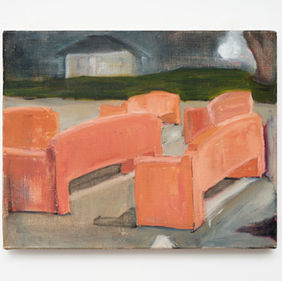Seven Hills
Myles Gable |
September 6 - November 1, 2025




































The title of Myles Gable’s debut solo exhibition Seven Hills at The
Meeting, refers to the seven hills that Seattle is built on and around, yet
there is no indication as to which hills this term refers to. Several of
Gable’s works in Seven Hills depict Seattle, the city where he grew up,
while others depict landscapes and scenes that would be impossible to
identify as Seattle with any certainty. The ambiguous nature of imagery in
Gable’s paintings, coupled with the uncertainties associated with the title
of the exhibition, presents Seattle as Arcadia. Arcadia is a mountainous
Greek province dating to antiquity, which in mythology is home to both
Hermes and Pan. In his 1502 poem “Arcadia,” the Neapolitan poet Jacopo
Sannazaro referred to it as a lost world of unattainable pastoral perfection,
populated by shepherds who exist in harmony with nature, uncorrupted by
the world. Sannazaro remembers Arcadia with regret and lamentation; it is
a dirge of paradise lost. For poets and artists alike, Arcadia has become
the term for utopian wilderness, for paradise.
In his 1637 painting The Arcadian Shepherds, Nicolas Poussin depicts
four Arcadian shepherds gathered at a tomb with the words “Et In Arcadia
Ego,” which translates roughly to “Even in Arcadia, there am I.” For this
message to be inscribed onto a tomb is to communicate that even in
Arcadia, death exists. This message is more explicitly communicated in
Giovanni Francesco Barbieri’s 1618 version of The Arcadian Shepherds,
which depicts a skull sitting on a stone bearing the same inscription, in
this instance being viewed by two shepherds instead of Poussin’s four.
Paradise becomes paradise lost through the succession of death upon
death. This is how Arcadia became extinct; mortality is the great inhibitor
of paradise. If Arcadia is heaven, death may also be the inflection point.
The mythological connotations of Arcadia are attendant in Gable’s Seven
Hills, as is death. In one painting, we see four figures, presumably nuns,
gathered at a railing overlooking a body of water. This grouping recalls
the shepherds of Poussin, while the composition is reminiscent of
Cezanne’s great Arcadian painting The Large Bathers (1900-1906),
replete with a church steeple on the shore in the distance. In Untitled,
2025, a massive hot and blue sky hangs above a terracotta field, a
graveyard full of tombstones that have been rubbed away from the surface
of the painting, with several crucifixes still rendered ghostly on a white
wall at the edge of the pink ground. This violent removal, a gesture that is
recurring in the paintings on view, is a reminder that death exists in
paradise, Et in Arcadia Ego.
Gauguin painted his vision of Arcadia in 1898, in a painting titled Where
Do We Come From? For Gable, perhaps the answer to Gauguin’s titular
question is Seattle. Seattle, like most of America, got messed up. Tech
geeks and fentanyl zombies are the presiding polarities that define the
spectrum of contemporary urban life. Trying to identify one’s place in the
oscillation between the two is depressing and frustrating, not to mention
very expensive. To witness the transformation from the Arcadian
shepherds of the past to the finance bros of the present is to witness the
demise of a place. Shuttered storefronts, tent cities, glass towers, and
Sweetgreens have replaced its idyllic urban landscape, now only
accessible through imagery and memory. The city whose end we lament
was murdered by a juggernauting procession of capitalism that seems as
preoccupied with decimating the city’s unique character as it does with
making its desecrated corpse slightly more profitable. The destruction
and subsequent reconstruction of our American cities is the production of
Arcadia. “The Seven Hills” is already a mythical concept because no one
knows which hills they are. Gable’s paintings, like Sannazaro’s poem, are
a lamentation of the lost paradise of his youth. Arcadia is a false memory,
and we cannot escape death. Even in Seattle, there am I. - Ned Vena
Myles Gable (b. 1996 Seattle, WA); Solo Exhibition: Seven Hills, The
Meeting, New York, NY, 2025; Group Exhibitions: Sensory
Archive, curated by Grayson Ritcher, 2025; Common Ground, Seattle,
WA, 2025; Small Format Painting Show, curated by Leo Fitzpatrick
& Josh Smith,105 Henry, New York NY, 2025; Garvey Flag “An Art
Show”, curated by Donyel Nicholas & Ivy-Royal, St Marks Open
Curatorial Exchange, New York, NY, 2025; Group Show, curated by
Grayson Ritcher, Common Ground, Seattle WA, 2025; Collegial
Currents, curated by Eduardo Medrano Jr. & Chris Scott, New York,
NY, 2024; Melt, curated by CHITO, Hometeam Gallery, Seattle WA,
2024; Jamais Vu, curated by KO Nnamdie, Anonymous Gallery, New
York NY, 2024; Bullet Symphony, Television Gallery, Chiang Mai TH,
2024; Can I just Chill? curated by Lilypad Magazine, Montreal Qc.,
2024.
THE MEETNG